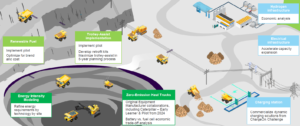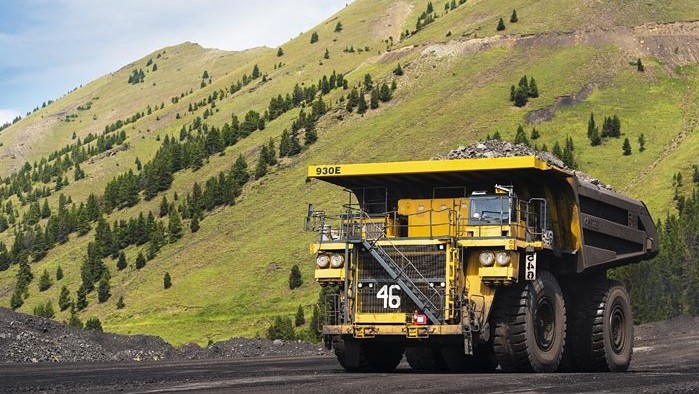On June 28, Canadian mining major Teck Resources held a Sustainability Investors Roundtable to highlight elements of its sustainability strategy and leadership. One focus area was titled Low Carbon Transition and was presented by Sepanta Dorri, VP Decarbonization and Chris Adachi, Director Climate Change. They talked about haul trucks as one of Teck’s Carbon Reduction Pathways in its goal to achieve 33% Scope 1 and 2 carbon intensity reduction by 2030 and net zero Scope 1 and 2 emissions by 2050.
Back in January 2022, Teck announced an agreement with Caterpillar Inc to work towards deploying 30 of Caterpillar’s zero-emissions large haul trucks at Teck mining operations. The companies plan to progress through a multi-phased approach together that includes early development, piloting and deployment of 30 Caterpillar zero-emission vehicles, including Cat 794 ultra-class trucks beginning in 2027.
Teck said in that announcement that it anticipates initially deploying zero-emissions trucks at its Elk Valley steelmaking coal operations in British Columbia, Canada, which include Fording River, Elkview, Greenhills and Line Creek. The operations are already powered by a 95% clean electricity grid, making it an ideal location to introduce one of Canada’s first zero-emissions large haul truck fleets, with options for trolley-assist technology.
The latest presentation states that Teck expects to receive its first “early learner” battery electric trucks from Caterpillar in late 2024/early 2025. These represent the next stage following late 2022/2023 testing of prototypes at the Tucson Proving Ground and Caterpillar has said these early learner units will help it and its customers refine requirements and do further process development plus product and technology validation. Caterpillar then says that the pilot phase begins in 2025 where the goal is to validate multiple trucks at the site; focused on fleet optimisation, including autonomy, getting infrastructure learning and also validating the production intent units. It intends to begin with full production in the 2027 timeframe.

Interestingly, though, the Teck presentation does not only focus on battery electric, stating that its future fleet work includes: “partnerships with OEMs and other miners to accelerate deployment of zero emission hydrogen and battery electric fleet at our mine sites.” It also mentions conducting a battery versus hydrogen fuel cell economic trade-off analysis. On charging, it says it will help commercialise dynamic charge solutions from the Charge On Innovation Challenge.
In the near term, Teck will pursue near term diesel displacement opportunities with renewable fuels and trolley-assist deployments; it has already trialled LNG use some years back. On the trolley topic, it says it intends to implement a pilot as well as develop retrofit kits and maximise the use of trolley assist as part of a five year planning process.
As stated, Elk Valley would seem to also be the focus for trolley implementation. There, Teck is proposing an extension to the existing 10 Mt/y Fording River Operations (FRO). The proposed extension is referred to as the Fording River Extension Project or FRX (previously known as the Castle Project). The FRX project area is adjacent to and south of the existing operations, and its extensive deposits of mineable steelmaking coal make it a logical extension of the Fording River Operations.
Beginning in the mid-2020s, less economic coal will be available from current FRO operating areas. Teck is proposing FRX to make up for this reduction in mineable coal. FRX is subject to a coordinated provincial and federal assessment process under the B.C. Environmental Assessment Act and federal Impact Assessment Act. The coordinated assessment will provide a comprehensive evaluation of the potential effects of the project. Informed by feedback from the Early Engagement Phase of the coordinated assessment process, Teck submitted the Detailed Project Description to the B.C. Environmental Assessment Office in July 2021. Teck anticipates that final provincial and federal assessment decisions would be released late-2023, and if positive decisions are received, permitting decisions in 2024. This would be followed by construction of the project with target for operations in 2027. Mining operations would then continue for several decades. By the early 2030s, all steelmaking coal for FRO would come from the FRX.
In order to reduce emissions, Teck is evaluating a number of options for FRX, which it has said includes trolley assist and more use of electrically powered conveyor systems. It will also be a focus for autonomous haulage – already being conducted in the Elk Valley at the Elkview mine, which, following a pilot, now operates a fleet of 42 autonomous Komatsu 930Es using the FrontRunner AHS technology. Autonomy alone reduces emissions via increased efficiency but of course will go hand in hand with battery electric haulage. Teck also has significant and long-term experience with Caterpillar autonomous trucks, with the fleet at its Highland Valley Copper mine now having reached 35 793F units across both the Lornex and Valley pits in late 2021/early 2022 and still working towards the full fleet of 52.
Back to battery electric and Teck Resources Ltd and technology company MEDATech are piloting a fully electric on-highway transport truck to haul copper concentrate, marking the first use of a battery-electric truck to haul copper concentrate worldwide. The truck will travel between Teck’s Highland Valley Copper Operations (HVC) in south-central British Columbia (BC) and a rail loading facility in Ashcroft, BC. This pilot of the MEDATech ALTDRIVE-powered fifth-wheel Western Star will help to advance Teck’s goal of displacing the equivalent of 1,000 internal combustion (ICE) vehicles by 2025. It will also provide valuable learnings for the electrification of Teck’s main mining fleets.











